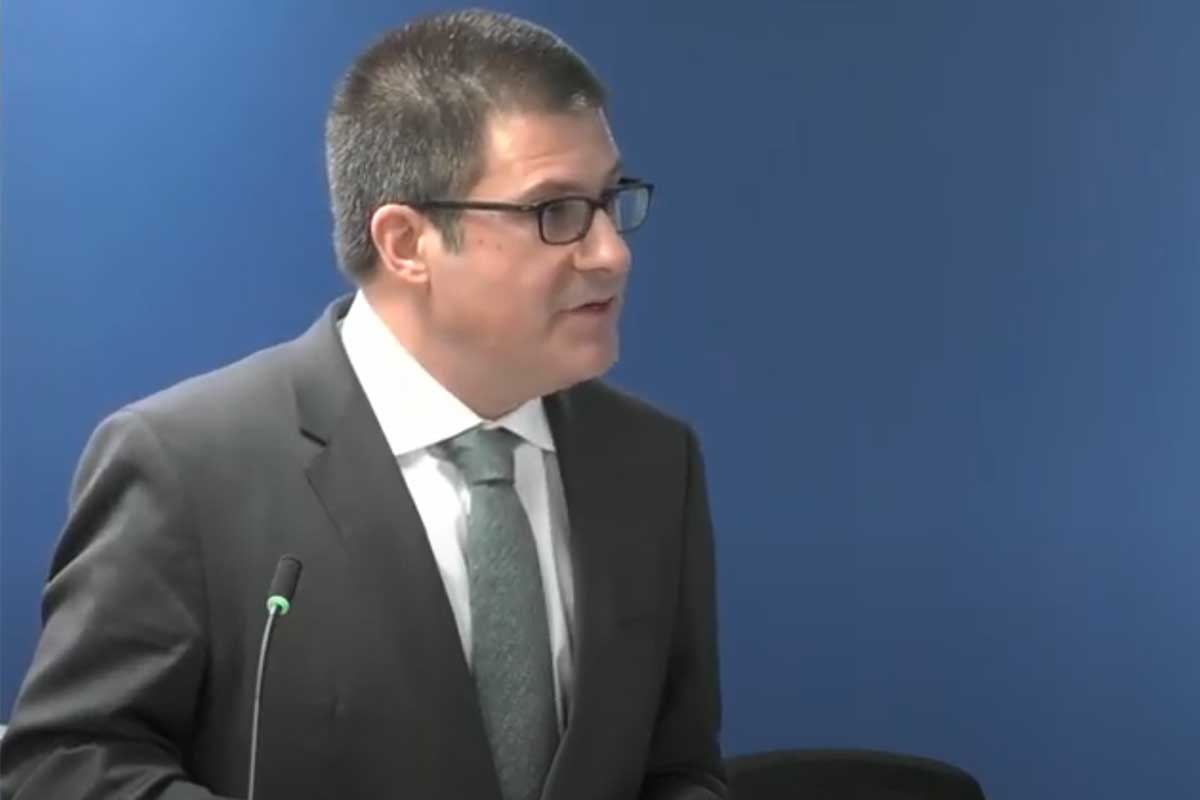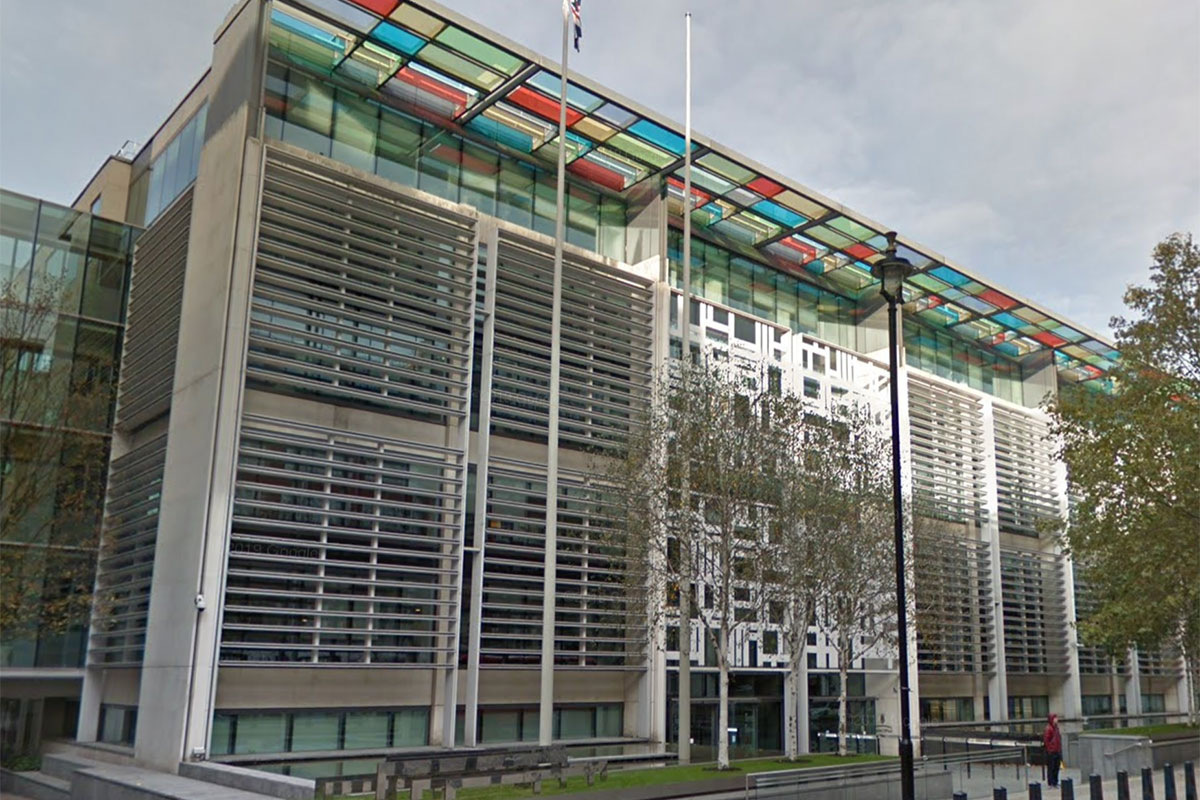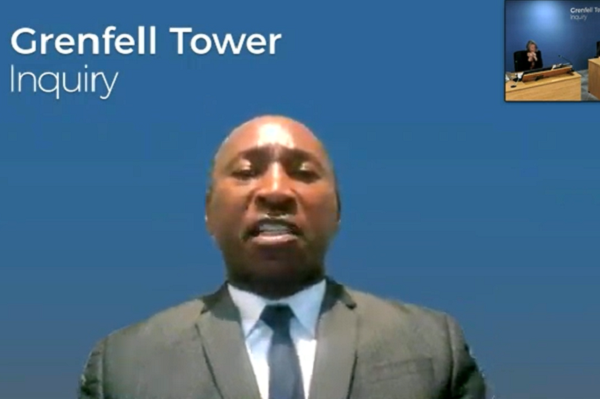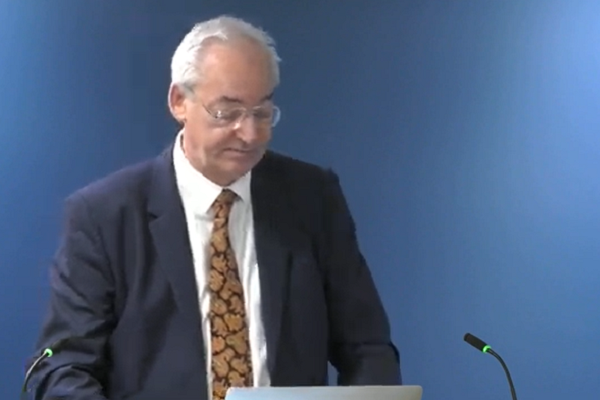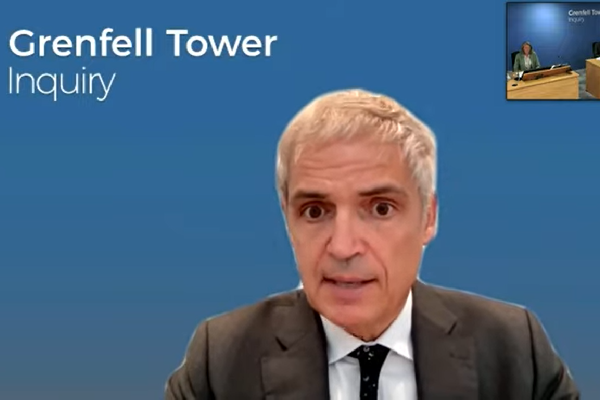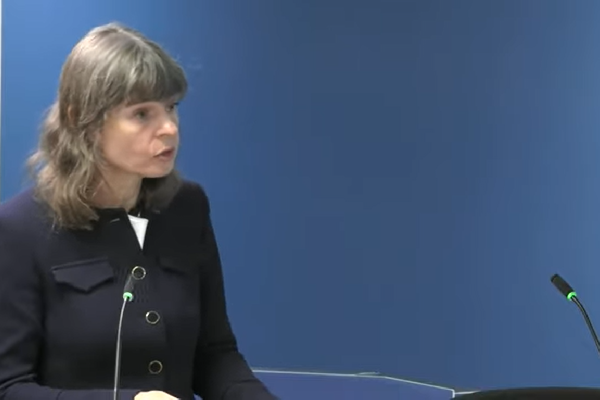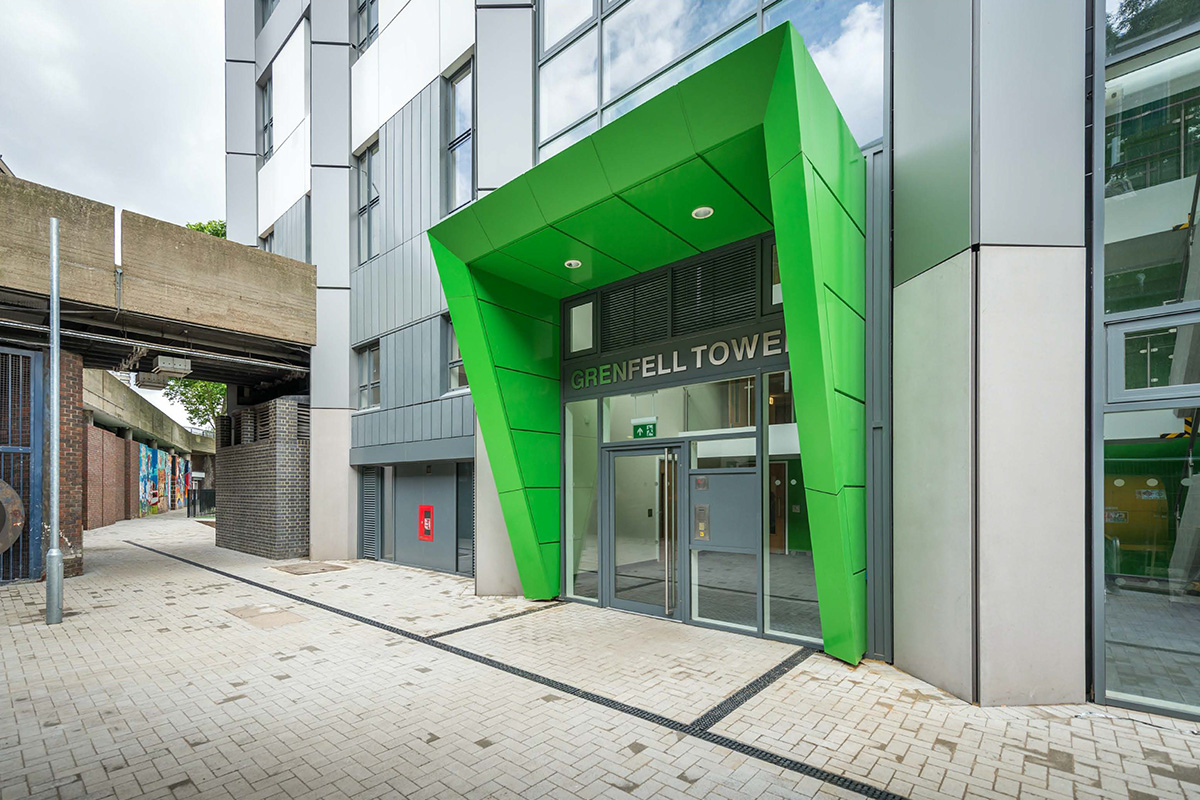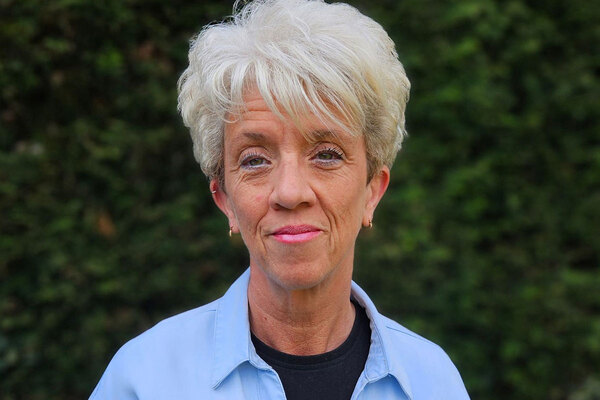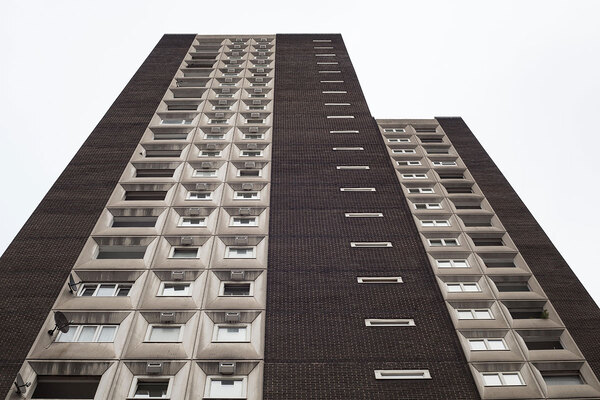Grenfell Tower Inquiry diary week 53: ‘They make for chilling reading and harrowing listening’
The inquiry’s investigation into central government began this week with lawyers setting out their view on how and why firefighting policies failed. Peter Apps and Lucie Heath report
On Thursday, 637 days after the mammoth second phase of the Grenfell Tower Inquiry began, it started its examination of the actions of central government in the years before the fire.
This module of the inquiry will be split into four parts: firefighting, testing and certification, fire risk assessments and the role of government more generally in maintaining building regulations and responding to recommendations from previous fires.
The openings on Thursday related to the firefighting section, with lawyers for the bereaved and survivors, the Fire Brigades Union (FBU) and the commissioner of the London Fire Brigade (LFB) giving oral statements.
The key points are summarised below.
‘The policy is one of benign neglect’
Speaking on behalf of one group of the bereaved and survivors, Danny Friedman QC (pictured) dedicated much of his opening to a history of UK fire policy – which he said contributed to the failures at Grenfell Tower.
He said that reviews of the service in the 1990s revealed the post-war fire service was “running aground”. These reviews called for change, but change was not forthcoming.
Instead, when Labour politician Nick Raynsford became fire minister in 2001, a senior civil servant told him “this won’t take up too much of your time”.
“The policy is one of benign neglect,” Mr Friedman quoted the civil servant (Philip Wood) as saying. “The fire service is a medium-sized problem: big enough to cause political trouble if confronted; small enough to be ignored without any apparent adverse consequences.”
In 2002, another review by Professor George Bain called for “change in the service from top to bottom”, in the words of Mr Friedman. This change was enacted with major reforms in 2004.
New Labour, he said, was seeking “modernisation” and “value for money”, as well as to take “an undeniable stand against certain aspects of FBU influence over the fire service”.
Mr Friedman called the union’s position “highly political”. He accused it of “playing to the gallery” and avoiding “open-minded conversation about what type of service was necessary to meet contemporary risk”.
The 2004 reforms introduced a policy of localism. The Central Fire Brigades Advisory Council, which had previously set standards and written policies, was abolished and specific policymaking pushed down to a local level.
Central government would retain the power to set national strategic aims – advised by its chief fire and rescue advisor – but specific policy decisions would now be taken at a local level.
When Labour was replaced with the coalition government in the early 2010s, this localism was “intensified… this time married to a deregulatory zeal”.
Inspections of fire services were axed and replaced with a less rigorous process of peer review. A national training college was sold to Capita, the outsourcing company.
The government was warned that this drive towards localism was not succeeding. Two reviews, one in 2013 and one in 2014, concluded separately that “localism had degenerated into siloism”, with some authorities “rejecting outside ideas and innovation”. But this warning was not heeded by government as it “cut too heavily across the grain of localism and the spirit of the red-tape challenge that prevailed at the time”.
At the same time, responsibility for firefighting was bounced between government departments and it underwent a more than 50% cut in staff. In 2013, a longstanding civil servant wrote that her team “no longer had access to the necessary technical expertise… to establish or determine the appropriateness of fire safety standards”.
The 2009 Lakanal House fire happened in this context: six residents died in south London after being told to “stay put” in a burning high-rise.
The coroner investigating this fire concluded in 2013 that national policy needed to be revised to “inform decisions on evacuation should it become clear during an incident that the stay-put principle is no longer tenable”. But after decades of “benign neglect”, was the government still capable of making such a change?
‘There is nothing like a funding cut to render a conservative and slow-to-change organisation that much more conservative and slow to change’
The key national guidance document in this context is Generic Risk Assessment (GRA) 3.2. This sets generic standards against which local fire authorities decide their policies.
The LFB had been asked to assist in redrafting this after the Lakanal House fire, but when civil servants saw a draft, they felt it “came up short”.
“The major criticism advanced by government was the lack of focus in the original draft on what incident commanders and the control room should do about stay put as a strategy when fire broke from the compartments of origin,” said Mr Friedman.
The Department for Communities and Local Government (responsible for this work, whose offices are pictured above) was also the government department that oversaw building regulations and had included references to the risks from cladding fires in various other policy documents.
“So why was that knowledge within government about a catastrophic risk not nationally highlighted or disseminated down into all fire services?” said Mr Friedman.
Ultimately, the GRA redraft would include instructions to consider evacuation, but this would not be developed into a national strategy. In particular, separate guidance to the social housing sector which encouraged total reliance on stay put and talked down the need to provide plans for disabled residents would not be revised.
The government “should have appreciated that this… combined dangerously with the lack of readiness on the part of operational firefighters to deal with a mass evacuation”, said Mr Friedman. It did not.
Then there was the effect of austerity, which led to a 28% cut to fire services nationally and 19.2% in London.
“There is nothing like a funding cut to render a conservative and slow-to-change organisation that much more conservative and slow to change,” said Mr Friedman.
The brigade felt it was “politically easier and more conducive to labour relations… to make savings in areas that did not reduce the number of fire stations, fire appliances or firefighters”.
Mr Friedman said: “This is significant, because while there is no sensible basis to argue that more firefighters, stations or appliances would have improved the LFB response to the Grenfell Tower fire, it is now obvious that better prevention, protection, policy and training would have done. Austerity prohibited those things.”
‘They make for chilling reading and harrowing listening’
A second opening statement for the bereaved and survivors was given by Professor Leslie Thomas QC (pictured above) and focused on ‘fire survival guidance’ calls (where a resident is trapped in a burning building and can’t escape).
He said the calls “make for chilling reading and harrowing listening” and “lay bare the threads of the institutional failings” within the LFB.
The calls he detailed certainly were upsetting. They included the El-Wahabis, a family of five on the 21st floor, who all died in the fire. The family first called 999 at 1.38am – around 45 minutes into the fire and 10 minutes after flames had reached the top of the tower. The call lasted for just under an hour.
As it progressed, the family explained that they were trapped by smoke and that the flat next door was on fire. But they were continually advised to stay put, and assured help was coming. Even as fire entered their flat and ignited their kitchen, they were not told to leave.
The family was eventually told to leave when they phoned back at 2.46am – but the operator told them to “cover yourself ... [in] wet towels, wet sheets, anything” but did not stay on the line. “Going to have to leave you ... got so many calls coming in,” Professor Thomas read from the transcript. “Caller: ‘You can’t leave.’ Operator: ‘Sorry, I ’ve got to go.’”
During the El-Wahabis’ call, other relatives – who lived in a flat lower down the tower – were watching from outside and saw the flames reaching the flat. They had implored them to flee.
Professor Thomas drew attention to the fact that the control room in Stratford did not have a television turned on during the fire: the control room operators could not see the pictures available to the rest of the world which showed the progress of the fire.
He read several other calls – some from residents who did eventually escape and others from those who died. These included residents with various vulnerabilities that made escape through the smoke-filled corridors particularly hard: asthma, pregnancy and young children.
This was not something the operators picked up on or explored – which Professor Thomas said “illustrate how poor training, poor practices and poor implementation of policies… might result in discriminatory practices and actions”.
More generally, he linked the failures in the call centre to austerity. He cited a 2013 report by Sir Ken Knight, the chief fire and rescue advisor for England at the time who now chairs the government’s independent expert advisory panel, which said cuts to control rooms “can and should be made”.
He also cited a 2017 report from the FBU which said control rooms had been “subjected to more than a decade of…cuts, mergers and under-investment”.
Mr Friedman also touched on the control room, saying that the LFB had considered privatisation before abandoning its plans and keeping the operation in-house but with the addition of a new IT system. He said technical problems with this system “had a significant effect on morale within the control room” and “arrested the development of the quality of the service”.
'They were swamped and did their best'
The lawyers for the bereaved and survivors were followed by short opening statements from lawyers acting for the FBU and the London fire commissioner.
Speaking for the FBU, Martin Seaward (pictured) said the control room was not equipped to cope with more than six calls from trapped residents at any one time.
The control room received 20 of these calls between 1.24am and 1.30am, which he said “outstripped the capacity” of both staff and policies.
“[The control room officers] were swamped and they did their best,” he said. “We say it’s unfair that they should have to bear personal criticism from this inquiry for shortcomings caused by the underlying systemic failings and their inability, despite doing their best, to overcome them in truly extraordinary circumstances.”
Mr Seaward called for the chair of the inquiry, Sir Martin Moore-Bick, to revise criticism of these officers in his report into the night of the fire if he were to conclude “the shortcomings on the night were largely due to systemic failings”.
This was echoed by Stephen Walsh QC, appearing for the commissioner, who said the brigade received more fire survival guidance calls on the night of the fire than in the previous 10 years combined.
“If there are failings, it is not of those individuals. They will be systemic. And the London fire commissioner was very firm about that,” he said.
Mr Walsh used most of his statement to emphasise the ways in which the LFB has changed since the Grenfell Tower fire.
This section of the inquiry will run for five weeks and will feature evidence from former LFB commissioner Dany Cotton and incumbent Andy Roe.
The broader investigation into central government will run until March 2022.
‘The residents were largely regarded as an inconvenience to be managed, rather than human beings’
The inquiry also heard closing statements this week from module three of the inquiry, which was concerned with the management of Grenfell before the fire, zeroing in on the Royal Borough of Kensington and Chelsea (RBKC) and Kensington and Chelsea Tenant Management Organisation (KCTMO), the arms-length body that managed the council’s housing.
On Monday morning the inquiry heard from Mr Friedman, who read a statement on behalf of a group of the bereaved, survivors and residents that characterised the Grenfell Tower inquiry as a “human rights disaster”.
These rights included their “consultation rights”, Mr Friedman argued. Despite a legal duty for local authorities to ensure tenants are consulted on major works, the inquiry has heard ample evidence that they were not.
“The residents were largely regarded as an inconvenience to be managed, rather than human beings. The fundamental feature of that attitude is the characterisation of the refurbishment as an act of generosity,” he said.
In its closing statement, RBKC admitted that a “mindset was present within the council” that led it to often believe KCTMO over residents, meaning “residents were not listened to as much as they should have been”.
KCTMO was less forthcoming. Its lawyer, James Ageros QC (pictured above), said its employees “were all well-intentioned and conscientious individuals who have made the vocational choice to work in social housing” and that it was “highly improbable that they would ever have deliberately and purposefully sought to deceive or disadvantage”.
‘A defeatist strategy of make do and mend, even if that meant compromising safety’
Mr Friedman also argued that KCTMO and RBKC breached residents’ “fire safety rights”. Throughout module three, we heard that much of the fire safety equipment in Grenfell Tower was broken or poorly maintained, including fire doors and the smoke ventilation system that went unrepaired for six years.
We also learned that KCTMO had built up a huge backlog of unresolved fire risk assessment actions in the years leading up to the fire and had been served multiple deficiency notices on its stock by the LFB.
Representing another group of the bereaved, survivors and residents, Stephanie Barwise QC said the “insufficient funding of social housing” led to a “defeatist strategy of make do and mend, even if that meant compromising safety”.
RBKC admitted to some fault here as well. For example, it said it was wrong for its head of housing, Laura Johnson, to oppose the introduction of a fire-door inspection programme and conceded that it failed to scrutinise KCTMO properly. However, it also pointed the finger at KCTMO employees for hiding fire safety issues from its board and not making a good enough case to RBKC for investment.
KCTMO denied that employees sought to deliberately keep information from its board. It acknowledged that “not all aspects of its management of the active and passive fire systems were optimal”, but said these systems were not “expected to perform in the extraordinary conditions that pertained on the night when non-compliant fire-propagating products, widely misrepresented and thus misunderstood, had been installed”.
A third right Mr Friedman argued the residents of Grenfell Tower were denied was their “right to equal treatment”, due to KCTMO’s failure to develop personal emergency evacuation plans (PEEPs) for residents.
We know that 41% of disabled residents living in Grenfell died on the night of the fire, alongside many residents who stayed behind to help them. Anne Studd QC, representing the mayor of London, said this should “fill us all with shame”.
On its failure to develop PEEPs, KCTMO said its actions were “no different than that of any other UK provider of general-needs social housing” and said the debate over whether PEEPs should be required within a block like Grenfell “remains unresolved at a national level to this day”.
RBKC pointed to conflicting guidance on the matter at the time and outlined the measures it is now taking to develop PEEPs as it waits for further government guidance on the matter.
The inquiry continues.
Grenfell Tower Inquiry headlines: week 53
Government fire policy ‘an abdication of responsibility to protect life’, inquiry hears
Policies of localism, deregulation and austerity with regard to fire services amounted to “an abdication of responsibility” by the British state with “disastrous consequences” at Grenfell Tower.
Grenfell residents ‘not listened to as much as they should have been’ council admits
A “mindset” existed within the Royal Borough of Kensington and Chelsea (RBKC) that meant Grenfell Tower residents were “not listened to as much as they should have been” before the fire, the council has admitted.
Grenfell Tower fire was ‘human rights disaster’, say lawyers for residents
The Grenfell Tower fire was a “human rights disaster” that was caused in part by the council and tenant management organisation’s “disrespect for human dignity”, the inquiry into the fire heard today.
Grenfell Tower Inquiry phase two: weekly diaries
Module one: the refurbishment
Week one: A vivid picture of a broken industry
After a week of damning revelations at the opening of phase two of the Grenfell Tower Inquiry, Peter Apps recaps the key points
Click here to read the full story
Week two: What is the significance of the immunity application?
Sir Martin Moore-Bick has written to the attorney general requesting protection for those set to give evidence at the Grenfell Tower Inquiry. Peter Apps explains what the move means
Click here to read the full story
Week three: Architects of misfortune
This week saw the lead architects for the Grenfell Tower refurbishment give evidence to the inquiry. Peter Apps runs through the key points
Click here to read the full story
Week four: ‘I didn’t have any perception that it was the monster it’s become’
The architects continued to give evidence this week, outlining a lack of understanding of the fire risk posed by the cladding materials and its design. Nathaniel Barker reports
Click here to read the full story
Week five: ‘No adverse effect in relation to external fire spread’
As the Grenfell Tower Inquiry returns from its long absence, Peter Apps recaps the key points from a week of important evidence from the fire consultants to the refurbishment
Click here to read the full story
Week six: ‘I can’t recall any instance where I discussed the materials with building control’
Nathaniel Barker summarises what we learned from fire engineers Exova, architects Studio E and the early evidence from contractor Rydon
Click here to read the full story
Week seven: ‘I do not think I have ever worked with a contractor operating with this level of nonchalance’
Two key witnesses from contractor Rydon gave evidence this week. Peter Apps recaps some of the key points from a revealing week of evidence
Click here to read the full story
Week eight: ‘It haunts me that it wasn't challenged’
Four witnesses from contractor Rydon gave evidence this week. Lucie Heath recaps what we learned on the last week of evidence before the inquiry breaks for five weeks
Click here to read the full story
Week nine: ‘All I can say is you will be taken out for a very nice meal very soon’
This week the inquiry heard evidence from witnesses at Harley Facades, the sub-contractor responsible for Grenfell Tower’s cladding. Peter Apps recaps the key points
Click here to read the full story
Week 10: ‘As we all know, ACM will be gone rather quickly in a fire!’
As the Grenfell Tower Inquiry entered its 10th week, Jack Simpson recaps the key points from a week of important evidence from the refurbishment’s cladding contractor
Click here to read the full story
Week 11: ‘Did you get the impression Grenfell Tower was a guinea pig for this insulation?’
With witnesses from the cladding subcontractor, the firm which cut the deadly panels to shape and the clerk of works which inspected the job giving evidence this was week full of revelations. Peter Apps recaps the key points
Click here to read the full story
Week 12: ‘Would you accept that was a serious failing on your part?’
With the surveyor who inspected Grenfell Tower for compliance giving evidence, this was a crucial week from the inquiry. Dominic Brady and Peter Apps report
Click here to read the full story
Week 13: ‘Value for money is to be regarded as the key driver for this project’
With consultants to Kensington & Chelsea Tenant Management Organisation (KCTMO) giving evidence, attention at the Grenfell Tower Inquiry turned for this first time to the actions of the TMO and the council. Peter Apps reports
Click here to read the full story
Week 14: ‘Did it not occur to you at this point that your budget was simply too low?’
This week, for the first time in phase two, the inquiry heard from Kensington & Chelsea Tenant Management Organisation, the landlord that oversaw the fatal refurbishment of Grenfell Tower. Lucie Heath reports
Click here to read the full story
Week 15: ‘Have you ever informed the police that you destroyed documents relevant to their investigation?’
Witnesses from the Kensington and Chelsea Tenant Management Organisation (KCTMO) gave evidence for a second week, which began with a shocking revelation about withheld and destroyed evidence. Peter Apps recaps
Click here to read the full story
Week 16: ‘I conclude this was very serious evidence of professional negligence’
This week saw members of Kensington & Chelsea Tenant Management Organisation finish giving evidence, before the inquiry’s expert witnesses took the stand to make some highly critical assessments of the work they had seen before and during the refurbishment of Grenfell Tower. Jack Simpson recaps
Click here to read the full story
Grenfell Tower: a timeline of the refurbishment
Following the conclusion of module one of the Grenfell Inquiry’s second phase, Peter Apps presents a timeline of the key moments during the fatal refurbishment of the west London tower block
Click here to read the full story
Module two: the cladding products
Week 17: ‘It’s hard to make a note about this because we are not clean’
The start of the second module of the Grenfell Tower Inquiry phase two came with some huge revelations about the companies that sold the products used in the cladding system. Peter Apps reports
Click here to read the full story
Week 18: ‘It was just reckless optimism wasn't it?’
As the inquiry began cross-examining witnesses for the second module of its phase two work, the picture surrounding just how Grenfell Tower ended up wrapped in such dangerous materials became a little clearer. Nathaniel Barker was keeping an eye on proceedings
Click here to read the full story
Week 19: ‘And that was intentional, deliberate, dishonest?’
The Grenfell Tower Inquiry this week heard the shocking story of how the insulation manufacturer “manipulated” official testing and marketed its product “dishonestly”. Peter Apps tells the story
Click here to read the full story
Week 20: ‘We were outed by a consultant who we then had to fabricate a story to’
This week the inquiry investigated the actions of Kingspan – the manufacturer of one of the insulation products used in the tower’s cladding system. Dominic Brady reports
Click here to read the full story
Week 21: ‘It’s there in black and white isn't it? We see a complete absence of any consideration of life safety’
The story of insulation giant Kingspan’s testing and marketing of its combustible insulation for high rises was unpacked in minute detail this week. Peter Apps reports
Click here to read the full story
Week 22: ‘All we do is lie in here’
In the third week of evidence from insulation giant Kingspan, the inquiry continued to uncover shocking details about the firm’s behaviour both before and after the Grenfell Tower fire. Lucie Heath reports
Click here to read the full story
Week 23: ‘That would have come as an earthquake to you at the time, would it not?’
This week the inquiry took its deepest dive yet into the inner workings of the cladding manufacturer whose product has been blamed for the terrible spread of fire up Grenfell Tower. Nathaniel Barker reports
Click here to read the full story
Week 24: ‘Do you accept that Test 5B was Arconic's deadly secret’
The president of the firm that made and sold the cladding panels installed on Grenfell Tower was asked to account for the apparent concealment of “disastrous” fire tests on the product this week. Peter Apps reports
Click here to read the full story
Week 25: ‘This is quite an incredible list of omissions and missed instances, isn’t it?’
This week the Grenfell Tower Inquiry heard its first witnesses from the Building Research Establishment (BRE) - the testing house which carried out key fire tests on the Kingspan and Celotex insulation products which were later used on Grenfell Tower. Peter Apps reports.
Click here to read the full story
Week 26: 'You were taking an enormous risk, weren't you?'
Week 26 at the Grenfell Tower Inquiry was a key moment in understanding how dangerous products used on the tower came to be accepted by industry professionals. Dominic Brady reports
Click here to read the full story
Week 27: ‘What will happen if one building made out [of] PE core is in fire and will kill 60 to 70 persons?’
The most explosive evidence this week at the Grenfell Tower Inquiry came from those who did not attend, as the evidence which would have been presented to Arconic witnesses was displayed in their absence. Peter Apps reports
Click here to read the full story
Week 28: ‘This is a serious safety matter’
This week the Grenfell Tower Inquiry zeroed in on the British Board of Agrément, the body that produced “misleading” certificates which inspired trust in both the cladding and insulation used on the tower. Lucie Heath reports
Click here to read the full story
Week 29: ‘Is it true that Kingspan’s position… was to do its best to ensure that science was secretly perverted for financial gain?’
The final week in this section of the Grenfell Tower Inquiry primarily examined the attempts by insulation manufacturer Kingspan to lobby government after the fire. Peter Apps reports
Click here to read the full story
How the products used in Grenfell Tower's cladding system were tested and sold
As the section of the Grenfell Tower Inquiry examining how the products used in the cladding system were tested, marketed and sold comes to a close, Peter Apps summarises what we have learned about each of the products included in the system
Click here to read the full story
Module Three: the management of the tower
Week 30: ‘There is certainly a high probability that in the event of a fire the whole building can become an inferno’
The focus of the inquiry shifted this week to the actions of the social housing providers responsible for maintaining Grenfell Tower. Pete Apps recaps what we learned
Click here to read the full story
Week 31: ‘If we cannot get out people will die’
This week saw the former residents of Grenfell Tower enter the witness box to tell of their experiences attempting to raise complaints with the council and its managing agent. Pete Apps reports
Click here to read the full story
Week 32: ‘Let's hope our luck holds and there isn't a fire’
This week saw the return of the landlord of Grenfell Tower, Kensington and Chelsea Tenant Management Organisation (KCTMO), as senior staff members attempted to explain how vital fire safety protections at the block were allowed to fall into disrepair. Lucie Heath reports
Click here to read the full story
Week 33: ‘Isn't that a serious gap in the scope of a policy meant to safeguard vulnerable people?’
A slightly disjointed week at the Grenfell Tower inquiry saw further evidence from staff at building manager Kensington and Chelsea Tenant Management Organisation (KCTMO) interspersed with the views of a cladding expert. Peter Apps reports
Click here to read the full story
Week 34: ‘Some members of the community are doing their best to spread false information’
Jack Simpson covers all the major revelations from the past week of evidence at the Grenfell Inquiry, including evidence from Laura Johnson, director of housing at the Royal Borough of Kensington and Chelsea.
Click here to read the full story
Week 35: ‘I really didn’t like the champagne’
This week the Grenfell Tower Inquiry saw council witnesses, including former deputy leader Rock Feilding-Mellen and leader Nicholas Paget-Brown, questioned about their role in the story for the first time. Peter Apps reports
Click here to read the full story
Week 36: ‘Is that not a very incurious approach for a fire risk assessor?’
This week the Grenfell Tower Inquiry scrutinised the work of Carl Stokes, the man hired to carry out fire risk assessments for the block. Nathaniel Barker reports
Click here to read the full story
Week 37: ‘In giving that advice, weren’t you acting beyond your knowledge and expertise?’
A curtailed week at the Grenfell Tower Inquiry saw fire risk assessor Carl Stokes grilled over advice he gave regarding the tower’s cladding. Peter Apps reports
Click here to read the full story
Week 38: ‘Well it’s a bit more than that, isn’t it. He’s suggesting that you tell the LFB a lie’
The inquiry heard the mammoth cross-examination of KCTMO’s health and safety manager Janice Wray this week. Peter Apps reports
Click here to read the full story
Week 39: ‘What you said there was a grotesque understatement’
This week the inquiry continued to hear from former employees of Kensington and Chelsea Tenant Management Organisation, as well as two employees from the London Fire Brigade. Lucie Heath reports
Click here to read the full story
Week 40: ‘An exercise in concealment and half-truth’
Former KCTMO chief executive Robert Black gave his evidence to the inquiry this week and was asked to account for the various failures described over the previous six weeks. Peter Apps and Nathaniel Barker report.
Click here to read the full story
Week 41: ‘We should do nothing. This is not the sort of website we should be responding to’
This week saw the return of Robert Black, chief executive of Kensington and Chelsea Tenant Management Organisation (KCTMO), before the inquiry turned its attention to the defective smoke control system in the tower. Dominic Brady reports
Click here to read the full story
Week 42:‘They would leak as much as they leaked. They were what they were’
The Grenfell Tower Inquiry continued its in-depth investigation of the tower’s non-compliant smoke control system this week, with evidence from the various contractors involved in delivering it. Pete Apps reports
Click here to read the full story
Week 43:‘Contractors at the time were not generally aware of the importance of leaving holes unsealed’
This week the inquiry focused on two of the more overlooked areas of the Grenfell Tower fire, with evidence focusing on the gas pipelines and lifts within the west London block. It was a packed week, with five witnesses giving evidence. Jack Simpson reports
Click here to read the full story
Week 44:‘I've never seen a fully compliant firefighting lift in any local authority building, to this day actually’
This week the inquiry turn the focus onto the building’s defective lifts, with evidence from an expert, contractors who worked on them and a former engineer at KCTMO. Pete Apps reports.
Click here to read the full story
Week 45: ‘Don’t you find all this rather a surprising debate, given that the Equality Act was passed in 2010?’
The inquiry heard from expert witness Colin Todd this week, who gave his views about the work of risk assessor Carl Stokes as well as answered questions about his own guidance. Peter Apps and Nathaniel Barker report
Click here to read the full story
Week 46: ‘I think I've been very, very clear that is completely wrong’
This week the inquiry heard further expert evidence about fire risk assessor Carl Stokes’ actions, as the section of its work covering the management and maintenance of the tower concluded. Peter Apps reports
Click here to read the full story
Six key failures in the way Grenfell Tower was managed before the fire
Peter Apps recaps some of what we have learned about the actions of the Royal Borough of Kensington and Chelsea (RBKC) and Kensington and Chelsea Tenant Management Organisation (KCTMO) in the years before the fire.
Module one and two closing statements
Week 47: ‘An unedifying spectacle’
After a week of closing statements from the core participants involved in modules one and two, Lucie Heath recaps the key arguments of each group
Click here to read the full story
Module five: the fire brigade
Week 48: ‘They knew, and lives could and should have been saved’
The phase of the Grenfell Tower Inquiry examining the actions of the London Fire Brigade in the years before the fire kicked off this week with some major revelations. Peter Apps reports
Click here to read the full story
Week 49: ‘I'm not sure we've always taken every opportunity to learn as an organisation’
How the London Fire Brigade acted upon lessons from incidents in the years before the Grenfell Tower disaster came under the microscope this week at the public inquiry. Nathaniel Barker reports
Click here to read the full story
Week 50: ‘There is a culture in LFB that is very conservative. I think there is great comfort in what is familiar’
This week the inquiry heard how the London Fire Brigade (LFB) elected not to issue warnings about dangerous cladding before Grenfell and a detailed examination of its policy for checking high risk buildings. Pete Apps reports.
Click here to read the full story
Week 51:‘We teach firefighters to expect building failure’
An unusually brief week of evidence at the Grenfell Tower Inquiry explored how a fire service neighbouring London was taking a different approach to tackling blazes in high rises. Nathaniel Barker reports
Click here to read the full story
Week 52: ‘I actually think that there is a measure of incompetence at all levels’
Expert evidence concluded the current section of the inquiry with some stinging criticism of the London Fire Brigade (LFB). Pete Apps and Grainne Cuffe report.
Click here to read the full story
Module six: fire services
Week 53: ‘They make for chilling reading and harrowing listening’
The inquiry’s investigation into central government began this week with lawyers setting out their view on how and why firefighting policies failed. Peter Apps and Lucie Heath report
Click here to read the full story
Week 54: ‘Our consideration of evacuation at this time was something of a blind spot’
The development of policy on ‘stay put’, both nationally and for London, occupied the attention of the inquiry this week. Peter Apps reports
Click here to read the full story
Week 55: ‘My review is pretty scathing!’
In a week that included the 200th day of evidence in phase two of the inquiry, attention turned to the London Fire Brigade’s control room. Lucie Heath reports
Click here to read the full story
Week 56: ‘Why didn't we thump the table harder’
This week, the control room at the London Fire Brigade was examined further – both before and after the fire. Pete Apps and Lucie Heath report
Click here to read the full story
Week 57: ‘It was worse than slow, it was sluggish’
Former London Fire Brigade (LFB) commissioner Dany Cotton was the star witness this week, as the inquiry continued to delve into the brigade’s knowledge and training before the Grenfell Tower fire. Jack Simpson, Grainne Cuffe and Pete Apps report
Click here to read the full story
Week 58: ‘I don't think we deserve to ask for trust until we demonstrate different outcomes’
A current and former commissioner of the London Fire Brigade (LFB) wrapped up the inquiry’s investigation into the actions of the brigade before the fire. Grainne Cuffe and Peter Apps report.
Module six: testing and government
One of the major scandals of our time: key revelations as the Grenfell Tower Inquiry turns to government
The government was accused of “covering up” the risks of dangerous cladding as its “unbridled passion for deregulation” left it a “junior party” to the construction industry as the latest phase of the public inquiry opened today. Peter Apps summarises some of the main points
Click here to read the full story
Week 59: ‘Recent tests have apparently shown it continued to burn for 20 minutes after the flame was taken away’
After shocking opening statements, the Grenfell Tower Inquiry turned its attention to the work of Local Authority Building Control. Pete Apps reports
Click here to read the full story
Week 60: ‘You could have an exact repeat of the Dubai fire in any number of buildings in London’
The Grenfell Tower Inquiry turned its attention to the work of the National House Building Council this week, with shocking revelations about the extent of the warnings issued to central government before the fire. Peter Apps reports
Click here to read the full story
Week 61: ‘Mistakes are meant for learning, not repeating’
In the first hearings of the new year, the Grenfell Tower Inquiry heard closing statements from the firefighting section of phase two. Lucie Heath reports
Click here to read the full story
Week 62: Did it ever occur to you that this act of collaboration was, in one sense, corrupting?
The Grenfell Tower Inquiry returned to the work of the National House Building Council (NHBC) this week, with a new shocking revelation about the government’s actions in the immediate aftermath of the fire. Peter Apps reports
Click here to read the full story
Week 63: ‘It came after the general move to deregulation. So more regulation was not welcome’
The government’s focus on deregulation before the Grenfell Tower fire was placed in the spotlight this week with a series of shocking revelations about its failure to amend fire safety guidance. Pete Apps and Grainne Cuffe report
Click here to read the full story
Week 64: ‘I didn’t think ACM would be suitable for use in any high-rise buildings. I don’t think anyone did’
This week, the Building Research Establishment’s Dr Sarah Colwell gave more than three days of evidence, with some huge revelations about what was known about the dangers of aluminium composite material years before the fire and the mass confusion over the government’s building regulations. Peter Apps and Jack Simpson report
Click here to read the full story
Week 65: ‘Unless the government does something now about ACM panels, people will die’
Further evidence from the Building Research Establishment and the first government witnesses added new depth to our understanding of how warnings were missed before the Grenfell Tower fire. Peter Apps reports
Click here to read the full story
Week 66: ‘Was there a cover-up?’
The latest evidence from the Grenfell Tower Inquiry tracked the government’s failure to act on fire safety warnings right up until the months before the fire. Peter Apps and Grainne Cuffe report
Click here to read the full story
Week 67: ‘When exposed to a fire, the aluminium melts away and exposes the polyethylene. Whoosh!’
This week the inquiry heard disturbing new evidence about the failure of senior government officials to act on warnings about dangerous cladding in the years before the Grenfell Tower fire. Peter Apps reports
Click here to read the full story
Week 68: ‘Can we agree that was a pretty dangerous thing to have, all this falling on one man’s shoulders?’
Three senior civil servants gave evidence this week, including the official who had responsibility for building regulations guidance on fire safety in the years before Grenfell. Peter Apps, Lucie Heath, Stephen Delahunty and Grainne Cuffe report
Click here to read the full story
Week 69: ‘It was just unthinkable. You had the makings here of a crisis you could not comprehend’
This week, civil servant Brian Martin gave his long-awaited evidence to the Grenfell Tower Inquiry. Peter Apps reports
Click here to read the full story
Week 70: ‘Show me the bodies’
An important week at the Grenfell Tower Inquiry saw a dramatic conclusion to the mammoth cross-examination of civil servant Brian Martin, as well as the first politicians. Peter Apps and Lucie Heath report
Click here to read the full story
Week 71: ‘I have changed my schedule to fit this in. I do have an extremely busy day meeting people’
Three politicians who were responsible for building regulations before Grenfell appeared before the inquiry this week, including the former communities secretary Eric Pickles, who responded to the coroner’s letter following the Lakanal House fire. Peter Apps and Lucie Heath report
Click here to read the full story
Module Four: aftermath
Week 72: 'The system isn't broken. It was built this way'
This week the inquiry turned to the shocking story of the lack of support for bereaved and survivors in the immediate aftermath of the Grenfell Tower fire. Peter Apps, Lucie Heath, Grainne Cuffe and Jack Simpson report
Click here to read the full story
Week 73: ‘Most people would regard that as hopeless’
This week, the Grenfell Tower Inquiry heard about the Royal Borough of Kensington and Chelsea’s chaotic response in the immediate aftermath of the blaze, from the staff responsible for it. Pete Apps, Stephen Delahunty and Grainne Cuffe report
Click here to read the full story
Week 74: ‘Do you agree that RBKC was ill-prepared and incapable to meet its duties’
This week, Nicholas Holgate, former chief executive of the Royal Borough of Kensington and Chelsea, was grilled on his failure to hand over control of the aftermath of the fire, despite the borough’s lack of capacity. Peter Apps reports
Click here to read the full story
Week 75: ‘It still shocks me to the core that that’s how we treat our citizens in this country’
This week the inquiry heard witnesses from the housing management body discuss their role in the aftermath of the Grenfell Tower fire, followed by a range of witnesses from other organisations which supported the response. Peter Apps and Grainne Cuffe report
Click here to read the full story
Week 76: ‘I fear this will become our New Orleans’
This week the inquiry heard from central government figures and members of the London-wide emergency response arrangements. Peter Apps and Grainne Cuffe report
Click here to read the full story
Week 77: ‘The planning wasn’t done and there was nothing for us to be drawing on’
The Grenfell Tower Inquiry’s examination of the aftermath of the fire concluded with witnesses from central government. Peter Apps reports
Click here to read the full story
Module seven: expert evidence and closing statements
Week 78: ‘The abandonment of the ‘stay put’ strategy for high-rise residential buildings is essential’
This week the Grenfell Tower Inquiry heard a range of expert witnesses discuss their reports. Peter Apps and Grainne Cuffe report
Click here to read the full story
Week 79: ‘You could argue the system was created to enable people to circumvent the rules’
The Grenfell Tower Inquiry continued to hear expert evidence this week, with two senior figures in the world of fire safety academia criticising the government’s approach before and after the blaze. Peter Apps and Grainne Cuffe report
Click here to read the full story
Week 80: ‘The evidence points to wilful blindness and complacency towards safety’
As the inquiry moves into its final stages, lawyers for the key players gave statements about the evidence surrounding central government. Peter Apps reports
Click here to read the full story
Week 81: ‘This is Islamophobia. It’s racism. It is the elephant staring back at us in the room’
This week, closing statements covering the aftermath of the fire delivered a shocking new revelation and an expert toxicologist gave his views on the causes of the deaths. Peter Apps reports
Click here to read the full story
Module eight: further evidence relating to the deceased
Week 82: ‘Their chance to hear about the circumstances in which their loved ones died is the culmination of five years of waiting’
The Grenfell Tower Inquiry moved into its final module this week, with evidence relating to the circumstances in which the victims died. Peter Apps reports
Click here to read the full story
Week 83: ‘They died together as they lived: caring for one another’
A second week of evidence relating to the circumstances in which the victims of the fire died delivered more heartbreaking stories about their final moments. Peter Apps recaps
Click here to read the full story
Week 84: ‘Every decision affects someone who is an adored child, a beloved sister, a respected uncle, a needed mother’
The final week of oral evidence for the Grenfell Tower Inquiry’s second phase contained more heartbreaking evidence about the deaths in the tower. Peter Apps reports
Click here to read the full story
Closing statements
Week 85: ‘The merry-go-round turns still, the notes of its melody clearly audible in the last few days’
The Grenfell Tower Inquiry returned this week for closing statements from lawyers representing the bereaved and survivors and the various parties under scrutiny for the fire. Pete Apps reports.

